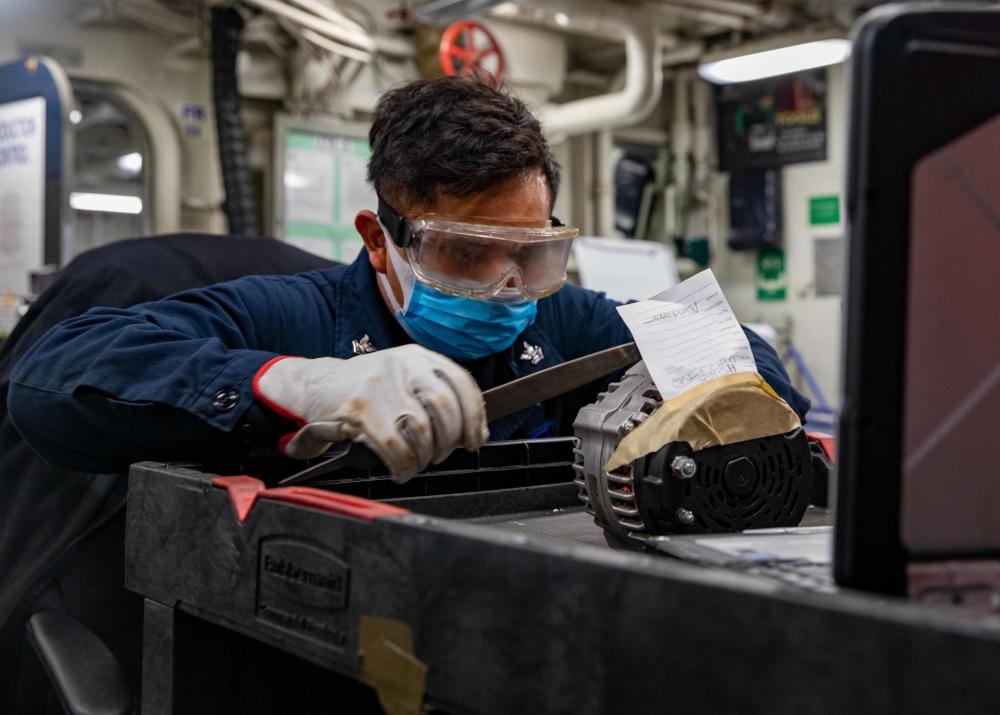The US Navy has completed first-of-its-kind repairs at sea on a F/A-18E Super Hornet that had been rendered inoperable after a fire incident, announced the service on January 14.
The F/A-18E Super Hornet, part of Strike Fighter Squadron (VFA) 136, had its repairs completed on January 9, 2023. The specialists executed the repair work from Fleet Readiness Command Centers (FRC) Southwest (FRCSW) and Southeast (FRCSE), the Navy said in a statement.
The engineers fixed the damage brought on by an in-flight starboard engine fire on August 31, 2022. The efforts made by the engineers reduced maintenance timelines while preserving operational readiness and mission capabilities of the Carrier Strike Group (CSG) 10 and Carrier Air Wing (CVW) 7, the Navy added.
The amount of fire and heat damage to the 68R door skin, vent screen, formers, S11 skin, starboard engine compartment, and all associated components would typically make the aircraft useless for the remainder of the deployment.
Furthermore, the aircraft would typically be craned off the ship and relocated to a facility that could handle repairs upon return to homeport.

Lt. Cmdr. Russell Huff, maintenance officer of CVW-7, said that the fire damage was extensive enough to require an engineering assessment to decide the feasibility of an at-sea repair. However, the service was determined to put the aircraft back in the air as soon as possible.
“Since this was the first-ever at-sea replacement of a 68R Door and S-11 Skin, considerable time was required to plan and approve the repair. Once the engineers had believed this repair could be accomplished at sea, or at least that a repair could be attempted, things went very smoothly,” Huff added.
How Did The US Navy Decide To Perform Repairs At Sea?
George H.W. Bush Carrier strike group is on a planned deployment in the area of operations of the US Naval Forces Europe to protect the interests of the United States and its allies.
On August 31, 2022, a F/A-18E Super Hornet’s engine caught fire during routine flying operations. The pilot took prompt action to land the plane safely on the Nimitz-class aircraft carrier USS George H.W. Bush by banking on the power of the second engine.
Upon landing, technicians examined the aircraft and discovered significant charring and burns on many components. The teams on board the ship weren’t happy with how things were.
To be craned off, the aircraft would have had to wait for repairs in the hangar bay. They, therefore, started working right away to persuade engineers that the repairs could be completed at sea.
After extensive talks, the FRCSW, FRCSE, and other commands at Naval Air Station (NAS) Oceana, NAS Sigonella, and Naval Station Norfolk organized the technical specialists, tools, and components for delivery to George H.W. Bush on deployment.

The Navy noted that it was essential to coordinate logistical activities across numerous bases, FRCs, and supply ships to demonstrate that the force could maintain its full capabilities at sea.
The service emphasized that while “the harmonization and relationship-building” took more than three months, the result was an increased tactical air capability for the deployed strike group.
It also paves a path for FRCs and deployed units to work together in similar circumstances in the future.
The work done by the FRC artisans demonstrates that it is possible to carry out vital maintenance work in a deployed setting, enhancing the US Navy’s fighting prowess and serving as a springboard for bringing even more robust repair capacity back to sea.
“Asset and operational readiness are inseparable—our ability to maintain and repair our aircraft while underway is a critical warfighting competency,” said Capt. Thomas Bodine, commander, CVW-7.
Bodine added that the Navy’s Carrier Air Wing force will be able to achieve decisive combat wins today, tomorrow, and for many years to come thanks to the resounding success of this critical at-sea repair and ones that will undoubtedly come after.
After the technicians and parts were brought on board, it ultimately took 33 days to finish these first-of-their-kind repairs at sea.
The repairs were completed while the aircraft carrier was in operation, proving the ability of deployed aircraft carriers to manage and employ a full spectrum of military weapons efficiently.
Overall, the success would enable the service to keep its air assets operational during times of conflict without worrying about transferring its aircraft to ground maintenance facilities.
- Contact the author at ashishmichel(at)gmail.com
- Follow EurAsian Times on Google News




